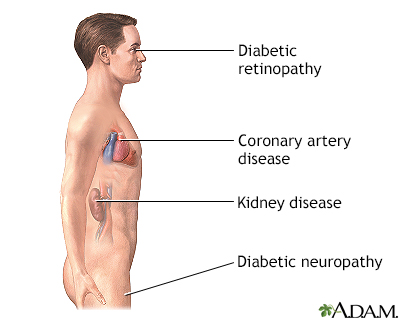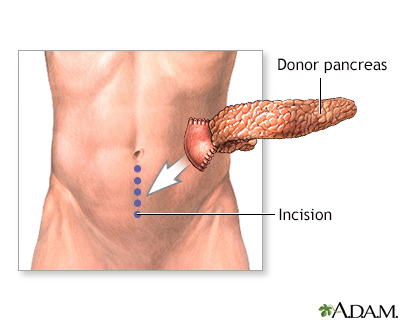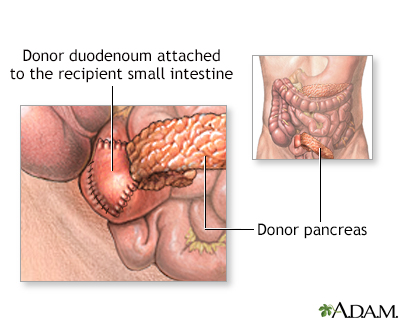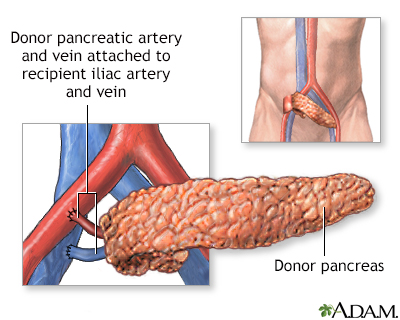Pancreas transplant - series

Normal anatomy
The pancreas resides in the back of the abdomen. It functions to produce digestive enzymes which are delivered to the small intestine (duodenum) and various hormones, which are delivered to the bloodstream. One of the most important hormones produced by the pancreas is insulin. Insulin is produced by specialized cells of the pancreas called islets of Langerhans. Insulin regulates blood sugar levels.

Indications
One of the most common diseases which affects the pancreas is insulin dependent diabetes, or type 1 diabetes. Type 1 diabetes is the result of an autoimmune attack on the islet cells which produce insulin. The resultant lack of insulin leads to excess blood sugar levels in the blood and a variety of health problems including visual disturbances (diabetic retinopathy), heart disease, nerve disorders (diabetic neuropathy), and kidney disease (diabetic nephropathy). Diabetic patients must take insulin everyday.

Incision
Pancreas transplant is a procedure in which a donor pancreas, obtained from a brain-dead organ donor who is maintained on life support, is surgically implanted into a diabetic patient. This operation is most often done in combination with kidney transplant in a patient who have diabetes and kidney failure as a result of their diabetes. The recipient's own diseased pancreas is left in place and the donor pancreas transplanted through a midline abdominal incision.

Procedure, part 1
The donor duodenum, which remains attached to the donor pancreas, is attached to the recipient's small bowel to allow the digestive enzymes produced by the donor pancreas to drain into the small intestine.

Procedure, part 2
The vessels of the donor pancreas are attached to the vessels in the groin that supply the leg.

Aftercare
Attempts have been made to isolate only the insulin producing islets from the donor pancreas and infuse these islets directly into the bloodstream of diabetic patients, where they would lodge in the tissues and produce insulin. While still an experimental procedure, "islet transplantation" may someday offer a treatment for diabetes that, unlike pancreas transplant, does not require a major surgery.
BACK TO TOP
Review Date: 9/9/2023
Reviewed By: Debra G. Wechter, MD, FACS, General Surgery Practice Specializing in Breast Cancer, Virginia Mason Medical Center, Seattle, WA. Also reviewed by David C. Dugdale, MD, Medical Director, Brenda Conaway, Editorial Director, and the A.D.A.M. Editorial team.

Health Content Provider
06/01/2025
|
A.D.A.M., Inc. is accredited by URAC, for Health Content Provider (www.urac.org). URAC's accreditation program is an independent audit to verify that A.D.A.M. follows rigorous standards of quality and accountability. A.D.A.M. is among the first to achieve this important distinction for online health information and services. Learn more about A.D.A.M.'s editorial policy, editorial process and privacy policy. A.D.A.M. is also a founding member of Hi-Ethics. This site complied with the HONcode standard for trustworthy health information from 1995 to 2022, after which HON (Health On the Net, a not-for-profit organization that promoted transparent and reliable health information online) was discontinued. |
The information provided herein should not be used during any medical emergency or for the diagnosis or treatment of any medical condition. A licensed medical professional should be consulted for diagnosis and treatment of any and all medical conditions. Links to other sites are provided for information only -- they do not constitute endorsements of those other sites. © 1997- 2024 A.D.A.M., a business unit of Ebix, Inc. Any duplication or distribution of the information contained herein is strictly prohibited.
